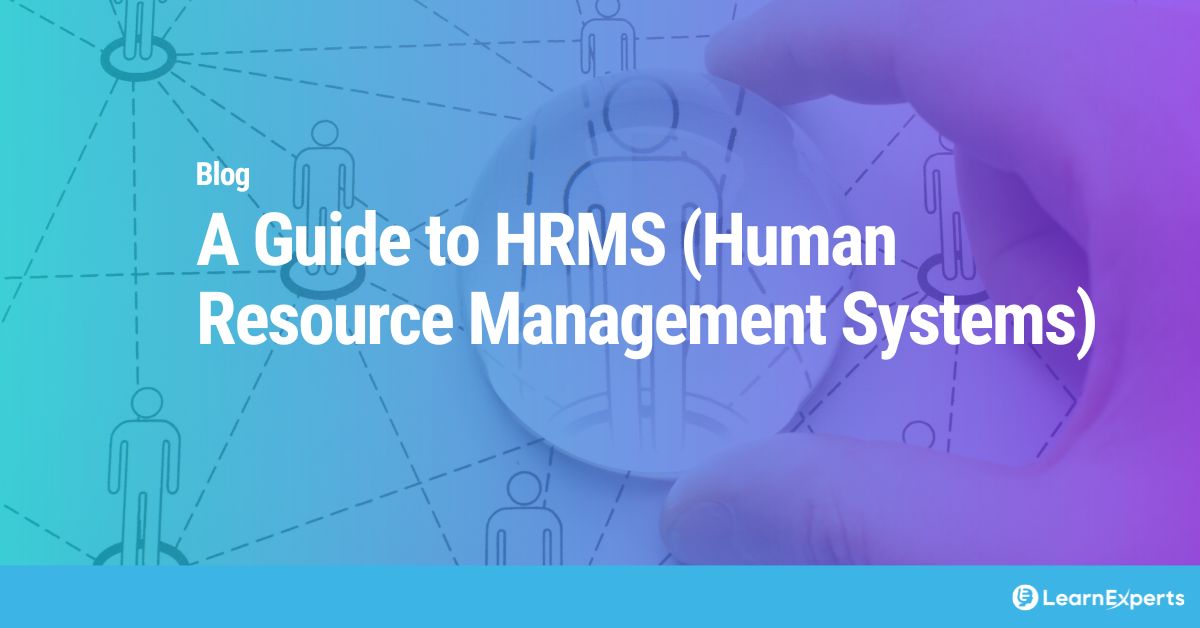Modern tools are a must for overworked HR teams that need to manage all aspects of the employee lifecycle including recruiting, hiring, onboarding, and training. One kind of HR tool is called human resource management systems (HRMS) and in this blog we cover the basics of this kind of software and features to consider.
Key takeaways
HRMS vs. HRIS: While often used interchangeably, HRMS typically includes more comprehensive features—covering both core HR functions and talent management tools.
Core features of HRMS: Modern HRMS platforms manage payroll, time tracking, employee onboarding, performance reviews, benefits, and more—all in one centralized system.
HRMS integration with LMS: Many HRMS platforms integrate with Learning Management Systems (LMS) to streamline employee training, track compliance, and support continuous development.
Improved analytics and decision-making: Built-in analytics help HR teams gain insights into workforce trends, performance, and engagement—leading to data-driven decisions.
- Choosing the right HRMS matters
Selecting an HRMS that aligns with your company’s size, structure, and goals ensures smoother adoption and greater long-term value.
What are Human Resource Management Systems?
HRMS’ are software solutions used by organizations to automate and manage HR operations. Previously these functions were done using paper-based methods or Human Resource Information Systems (HRIS). Modern HRMS applications are available to provide complete integrated HR functions which are in the cloud and can enable remote and secure operations using the internet.
What is the difference between HRMS and HRIS?
According to software giant Oracle, HRIS connects various HR processes such as benefits, workforce management, payroll, and core HR. HRMS software on the other hand, offers a greater suite of modules and features compared to HRIS’ including employee data management to payroll, recruitment, benefits, training, talent management, employee engagement, employee attendance and employee self-service.
In short, HRIS is a subset of human resource management systems.
Key functions of an HRMS
To maximize value an HRMS software solution, it should include these key integrated HR functions:
Recruiting and Onboarding – HRMS can speed up sorting applications, accelerate progressing candidates through the post-recruitment phases and automatically progress candidates to the next phases in the hiring process.
HR Analytics – HRMS analytics modules can efficiently produce metrics on key areas such as offer acceptance, absenteeism, training costs and efficiency, turnover rates, revenue per employee, resource gaps, alerts on time to fill roles. HRMS analytics modules can also produce all-around employee performance reporting.
Payroll Management – HRMS with payroll can help to make this complex task error free and efficient. Payroll management functionality may include everything from on-boarding, leave management, attendance, expense reimbursement, reviewing payslips and customized reporting.
Attendance and Absenteeism Management – HRMS can automate tracking time and attendance eliminating errors and confusion.
Learning and Development – HRMS can include a learning and development module with a training portal, role-based and goal-based training recommendations and management, individual user learning plans and learning administration. A centralized cloud based HRMS with learning and development modules can enable fast uploads and downloads, anywhere/anytime management, centralized training documentation and videos, and can include calendar options for employee performance goal scheduling.
Employee Information Management – Reporting and easy access to real-time employee information are key to managing employees effectively. A centralized cloud-based HRMS can provide HR team members rapid access to backed-up, secure and accurate data, some of which may be sensitive and confidential for the business. A secure ESS (Employee Self-Serve) portal will allow employees access to their own data while providing the opportunity to keep their own data current.
Disciplinary Action Management – This function allows the HR team to track cases, penalties, and history of disciplinary actions, ensuring internal disciplinary policy is followed.
Exit Management – This function can help HR teams manage an effective offboarding process including tracking exit interviews – a great way to understand areas that are not satisfying employees’ needs, providing the ability to create strategies to address them.
According to Gartner, your HRMS solution should prioritize these 11 capabilities
- Absence management
- Core HR
- Performance management
- Product usability
- Self-service processes
- Compensation management
- Employee benefits
- Employee onboarding
- Learning management
- Payroll
- Succession planning
Benefits of HRMS software
While the key benefit of HRMS is effectively performing the tasks necessary to manage a talented workforce, other benefits include:
Greater Employee Engagement – Employees who experience an effective HRMS from first interaction through their ongoing performance management will feel more challenged, mentored, and valued while meeting business goals, leading to greater employee satisfaction, and higher retention. Engagement also supports greater employee inclusion.
Greater Security – Employee data security via data encryption and role-based access control is a core capability of a good HRMS. Having all employee data in one secure location can provide employer and employee peace of mind.
Reduced Administrative Effort – Unlike paper-based or Human Resource Information Systems, HRMS provide efficient storage and management of all employee data, reducing back-end data management effort. Cloud-based HRMS solutions can also provide secure, anytime/anywhere access without on-site data storage and maintenance overhead.
More Performance Insights – Accurate HRMS employee data enables analysis, planning and forecasting leading to better HR decisions. HRMS reporting and analytics can lead to better understanding workforce gaps, anticipating recruiting needs and identifying potential problem areas early, such as high employee turnover for certain roles.
Integrated HRMS-LMS (Learning Management System)
Some HRMS solutions provide an integrated learning management system, providing benefits for employees, HR teams and managers. LMS’ offer many benefits including:
- Organizes online training or eLearning in one location.
- Provides unlimited access to learning materials.
- Allows learners to set their learning pace.
- Allows learners to take learning when they need or have time.
- Allows learning to be available on various devices, including mobile.
- Keeps organization updated with compliance to mandatory learning.
- Allows organization to release new eLearning courses across the organization.
- Integrates social learning experiences.
- Get learning metrics including attendance, completion rate and assessment results.
Benefits of an integrated LMS in HRMS
One System for HR and Training – Functional managers and HR teams can access employee skill set and performance data from one location eliminating manually integrating data from multiple separate systems. Integrated data sets enable better data analysis and reporting supporting managers’ decision making.
Early Training – An LMS offers the ability to offer “pre-boarding” where a soon-to-be employee learns about the organization’s standards and culture. Once an employee has come onboard, employee goals and targets can be assessed and assigned during the onboarding stage.
Improved Talent Management – Managers can take advantage of integrated employee data analysis insights to understand learned skills and review performance assessment reports to assess outcomes of completed training. Skill growth can be better determined while knowledge of acquired skills can avoid repeated training, avoiding unnecessary costs and employee dissatisfaction.
Better Retention – Employees who are learning and growing are more satisfied and less likely to become flight risks.
Best HRMS software?
There are many HRMS options. Selecting the one that is right for your organization depends on factors like location, number of employees, industry, deployment preference (cloud or on-premises) and purchasing options. Each of these need to be considered.
Some websites provide tools to assess and rate solutions to help you find the best HRMS software for you. These include HRMS World, Capterra and People Managing People. Some well known industry options offered by SHRM (Society for Human Resource Management) include: DP Vantage HCM, APS, Ascentis, BambooHR, Ceridian Dayforce, Fairsail, Halogen, Kronos Workforce Central, Oracle HCM Cloud, Patriot, SAP SuccessFactors Employee Central, Workday Human Capital Management.
Creating learning for your HRMS
As seasoned learning creators, we have seen time and time again that people underestimate the time it takes to build the content for a course which can hinder the success of an LMS-enabled training program. Many HR teams use a traditional process where an HR specialist interviews subject matter experts (SMEs) and then translates this into a course using tools like Word or PowerPoint. This is a long and manual process that requires time and expertise.
To increase the speed and success of course creation, we created LEAi, our learning content creation tool. This AI-enabled tool allows companies to use documents and presentations that others have already created to build the content for training courses.
- Create the course structure, learning objectives, and test questions in seconds.
- Be guided by best practices with our LearnAdvisor.
- Repurpose content easily for different modules and courses.
- Develop microlearning with a single mouse click.
- Automatically create test questions to assess how well the content was understood.
The output from LEAi can be used to produce the content for an LMS. If you are looking for a way to quickly develop learning content for the LMS within an HRMS, give us a call. We will save you lots of time and money!




